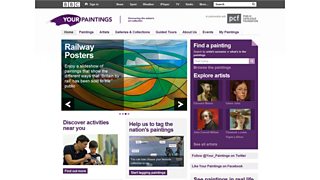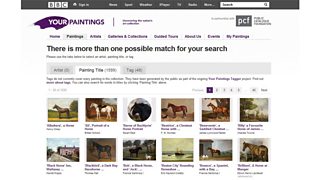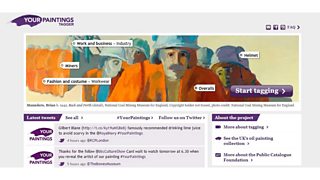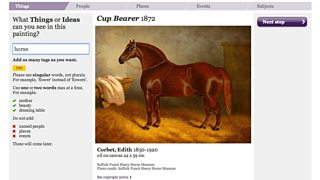Hi I'm Nat Smith a freelance digital project manager. I helped co-ordinate the creation of the site.
My colleague about the public beta launch of Your Paintings in 2011.
Now the digitisation and publishing of the paintings is , we thought it would be a great time to look back on how the Your Paintings site was put together and share some of the thinking and approach used for the creation of the site.

What is Your Paintings?
Before going any further I should explain what Your Paintings is.
The Your Paintings website contains images of all the UK's oil paintings supported by public funding. It is a vast collection of over 200,000 paintings, well 211,879 to be exact, from famous pieces such as to .
The paintings donβt just reside in galleries and museums, they are also in many unusual locations such as .
Your Paintings was built in partnership with the (PCF) who photographed and catalogued the paintings which enabled us to put them online.
The Hidden Paintings
These paintings are an incredible cultural asset for the UK yet only around 20% of them are on display at any one time, there is simply not enough wall space to display them all. Many of the paintings are in permanent storage, accessed only by researchers by special request.
One of the main goals of Your Paintings was to right that wrong, to provide the facility for everyone to engage and enjoy the paintings they fund.
Unknown unknowns
Another surprise is how little data existed for the paintings. For many the artist is unknown as is other information such as the title and date it was painted.
Where information did exist it tended to be only for the most frequently displayed paintings, not the 80% in storage.
Large number of images
One of the core principles of the website was for it to be accessible to anyone, regardless of their knowledge of art history.
So we have a large set of images with a small amount of data associated with them. How can this be presented so a non-art enthusiast can both engage with and use the site? How can someone browse over 200,000 images?
These were the first questions to answer.Μύ

Searching for images in Your Paintings
User Research
User research underpinned the thinking behind the Your Paintings website.
From direct audience research we saw that people really wanted to know more about oil paintings but expressed they did not feel they knew enough about art or art history to engage with the subject.
We looked at how people approach art, both in physical spaces and on the web. We also looked at how people search for images generally on the web, looking at sites such as , , Google Images and analysing image search terms.
We also looked into the world of online shopping. Many shopping sites are trying to present a large catalogue of items that need to be easily searched and browsed just like the Your Paintings site.
It would be impossible to condense all the research into one blog posting but here are two key findings.
1. People rarely search for titles, they search for content based on subject.
2. is one of the most effective ways to enable search by content.
From the insight into search data we saw only a small number of artists are searched for by name and an even smaller number of paintings are searched for by title.
Looking at research data for general image searching we saw people are looking mainly for image content. Examples of this are βDogsβ, βBoatsβ, βWinston Churchillβ, βMatlockβ, βThe Great Fire of Londonβ, or put another way Things, People, Places, Events and Subjects.
Therefore, to open up this collection of paintings we decided this set of images needed to be accessible via searches against Things, People, Places, Events and Subjects in addition to the typical information stored against paintings such as Artist, Painting Title, Style and Type.
The user would not need to know artist names or painting titles to find paintings that could interest them.
Research into online shopping showed us that faceted search is one of the best ways to browse through large collections of images.
To understand faceted search imagine you are shopping for a coat online. Perhaps you would start your search with the term βmenβs coatsβ. The shopping site would then present the facets, or attributes associated with coats for example size colour, style and brand name.
The search could then be narrowed to medium, brown coats for winter made by Acme Corporation. The search could then be enlarged to show for example both brown and blue coats.
If you have used many online shops you will be sure to have seen faceted search in action.
The same could be true searching for images of paintings. For example you could start by looking for pictures of boats then narrow or enlarge the search based on paintings facets such as People, Places, Events, Styles, Types and Artist. Pictures of anyone?

The Your Paintings Tagger
How can this be done?
As mentioned previously very little data, or (data about data content), was available for the majority of the images. How could enough metadata be associated with each image to enable a faceted search?
We found the answer using the .
Many Hands make light work
We looked around for websites which had tackled similar a problem in classifying large data sets. We sought advice from the and technical director Arfon Smith was incredibly helpful in advising and assisting with the solution.
Their approach is simple in concept and incredibly powerful. It is based on statistical probability. For example if you show an image to a large number of people and most of those people state there is a lighthouse in the image then in all likelihood there is a lighthouse in the image.
The thresholds can be adjusted in terms of the number of people you need to look at the image and the number of those that need to identify the object.
The product of this was the .
Tagger
The Your Paintings Tagger website is used to create the metadata underpinning the faceted search on Things, People, Places, Events and Subjects in the Your Paintings site. Users can log on and tag images with keywords associated with the content of the painting.
, you donβt have to be an expert to do this anyone can get involved. Your help is still needed. If you have the time and interest please do take part in the Your Paintings Tagger, the more tagging that is done the richer the faceted search becomes.

Tagging in the Your Paintings Tagger
The metadata captured by the Tagger is processed by the Tagger engine and sometime later transferred across to the Your Paintings database of metadata to support a search.
I hope this blog post gives some insight into the thought and mechanics behind the Your Paintings website.
Please get in touch, we welcome your comments and questions, we will try to respond to as many questions as we can.
Nat Smith is a freelance digital project manager.
